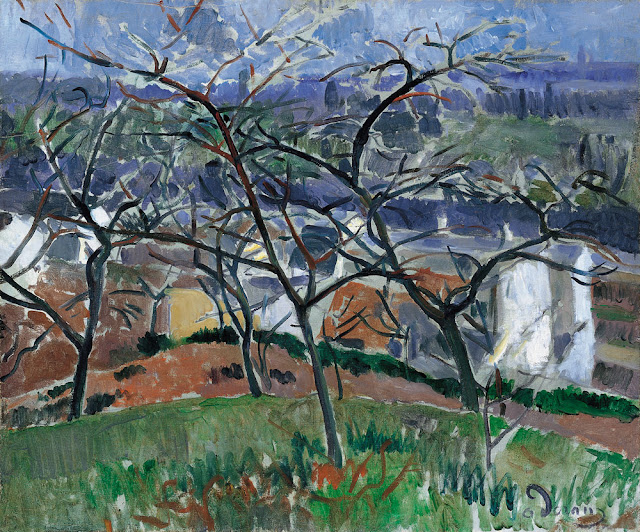 |
| Henri Lebasque (France) On the banks of the River Marne near Montévrain ca. 1900 oil on canvas Museo Thyssen-Bornemisza, Madrid |
"The museum, a consecrated building presenting objects withheld from private appropriation and predisposed by economic neutralization to undergo the 'neutralization' defining the 'pure' gaze, is opposed to the commercial art gallery which, like other luxury emporia (boutiques, antique shops, etc.) offers objects which may be contemplated but also bought, just as the 'pure' aesthetic dispositions of the dominated fractions of the dominant class, especially teachers, who are strongly over-represented in museums, are opposed to those of the 'happy few' in the dominant fractions who have the means of materially appropriating works of art. The whole relation to the work of art is changed when the painting, the statue, the Chinese vase or the piece of antique furniture belongs to the world of objects available for appropriation, thus taking its place in the series of the luxury goods which ones possesses and enjoys without needing to prove the delight they give and the taste they illustrate, and which, even when not personally possessed, belong to the status attributes of one's group, decorating the offices one works in or the salons one frequents."
 |
| André Derain (France) Landscape near Chatou 1904-05 oil on canvas Museo Thyssen-Bornemisza, Madrid |
"The appropriation of symbolic objects with a material existence, such as paintings, raises the distinctive force of ownership to the second power and reduces purely symbolic appropriation to the inferior status of a symbolic substitute. To appropriate a work of art is to assert oneself as the exclusive possessor of the object and of the authentic taste for that object, which is thereby converted into the reified negation of all those who are unworthy of possessing it, for lack of the material or symbolic means of doing so, or simply for lack of a desire to possess it strong enough to 'sacrifice everything for it'."
 |
| Maximilien Luce (France) Thicket, Montmartre ca. 1904 oil on canvas Museo Thyssen-Bornemisza, Madrid |
"The exclusive appropriation of priceless works is not without analogy to the ostentatious destruction of wealth; the irreproachable exhibition of wealth which it permits is, simultaneously, a challenge thrown down to all those who cannot dissociate their 'being' from their 'having' and attain disinterestedness, the supreme affirmation of personal excellence."
 |
| Henri Manguin (France) Model resting 1905 oil on canvas Museo Thyssen-Bornemisza, Madrid |
"But in the absence of the conditions of material possession, the pursuit of exclusiveness has to be content with developing a unique mode of appropriation. Liking the same things differently, liking different things, less obviously marked out for admiration – these are some of the strategies for outflanking, overtaking and displacing which, by maintaining a permanent revolution in tastes, enable the dominated, less wealthy fractions, whose appropriations must, in the main, be exclusively symbolic, to secure exclusive possessions at every moment."
– quoted passages are from Distinction : a social critique of the judgement of taste by Pierre Bourdieu, translated by Richard Nice (Harvard University Press, 1984)
 |
| Georges Braques (France) Seascape, L'Estaque 1906 canvas Museo Thyssen-Bornemisza, Madrid |
 |
| André Derain (France) Waterloo Bridge 1906 oil on canvas Museo Thyssen-Bornemisza, Madrid |
If well thou viewest us with no squinted eye,
No partial judgement, thou wilt quickly rate
Thy wealth no richer than my poverty,
My want no poorer than thy rich estate,
Our ends and births alike: in this, as I,
Poor thou wert born and poor again shalt die.
My little fills my little-wishing mind;
Thou having more than much, yet seekest more:
Who seeks, still wishes what he seeks to find;
Who wishes wants, and whoso wants is poor.
Then this must follow of necessity:
Poor are thy riches, rich my poverty.
– from Phineas Fletcher's poem, Against a Rich Man Despising Poverty (1633)
 |
| Maximilien Luce (France) Yonne, the road to Vermenton 1906 oil on canvas Museo Thyssen-Bornemisza, Madrid |
 |
| Maurice de Vlaminck (France) Blue Vase with Flowers ca. 1906 oil on canvas Museo Thyssen-Bornemisza, Madrid |
 |
| Maurice de Vlaminck (France) Fields, Rueil ca. 1906-07 canvas Museo Thyssen-Bornemisza, Madrid |
 |
| Raoul Dufy (France) The Little Palm Tree ca. 1907 oil on canvas Museo Thyssen-Bornemisza, Madrid |
 |
| Robert Delaunay (France) Still-life with Parrot 1907 oil and wax on canvas Museo Thyssen-Bornemisza, Madrid |
 |
| James Ensor (Belgium) Theater of Masks 1908 oil on canvas Museo Thyssen-Bornemisza, Madrid |
 |
| Max Pechstein (Germany) Horse Fair 1910 oil on canvas Museo Thyssen-Bornemisza, Madrid |
 |
| Childe Hassam (USA) The French Breakfast 1910 oil on canvas Museo Thyssen-Bornemisza, Madrid |
I am grateful to Museo Thyssen-Bornemisza for the excellent reproductions.